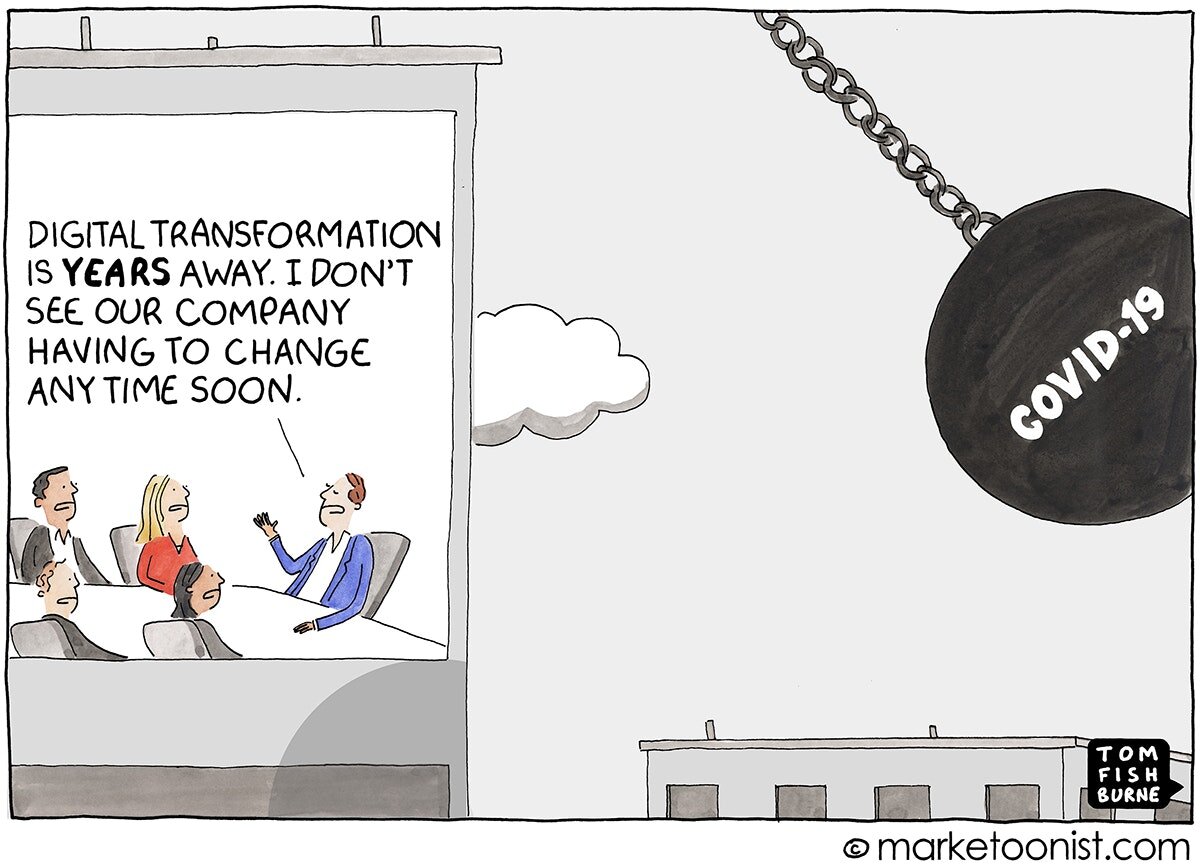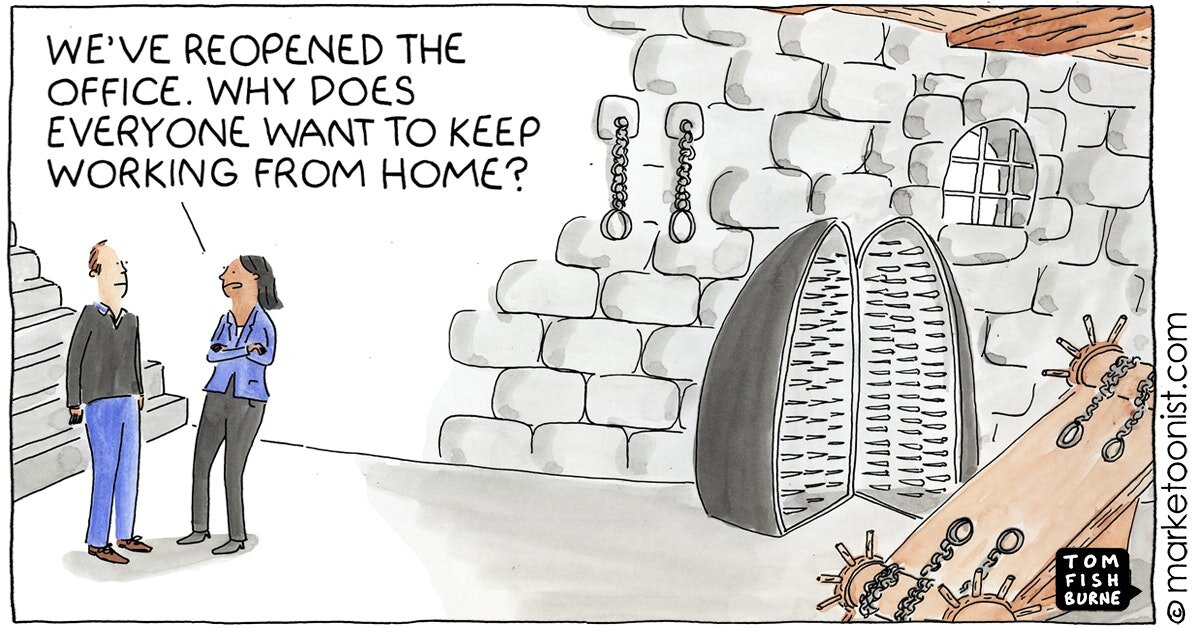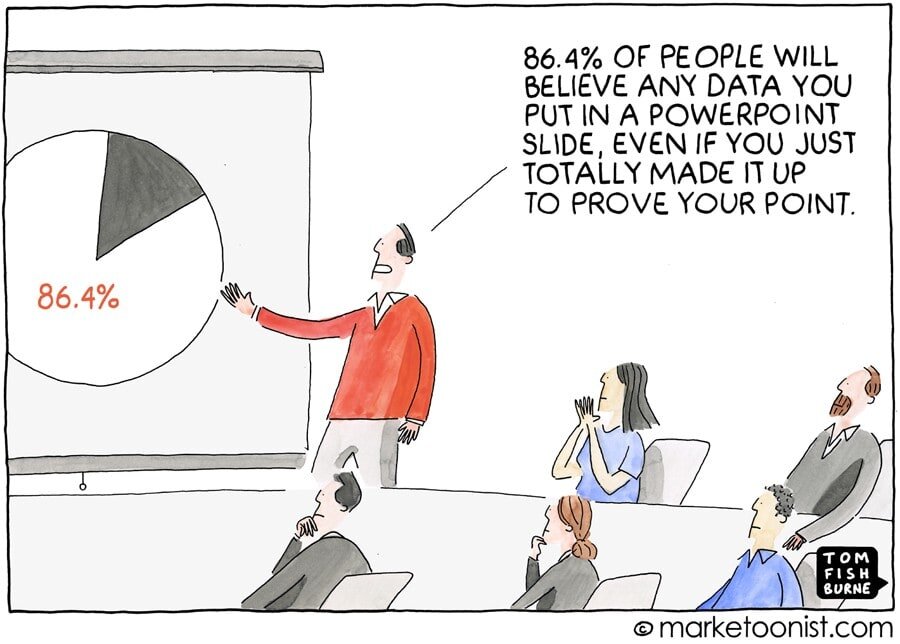How to Thrive in the Modern Workspace
Cartoon by Tom Fishburne
Work is central to the Human Experience.
It provides income, identity, community and meaning.
The trauma of a job loss is second only that to the death of a loved one.
Three inter-acting forces are sculpting a new terrain for the future of work.
1. Globalization which while creating wealth overall can be devastating for communities and industries in many regions. Both globalization itself and a backlash to it will shape the contours of opportunities (or their loss) for everyone
2. The three A’s of technology (automation, algorithms, artificial intelligence) which accelerate middle-class income job loss at speeds far greater than jobs they create. Another major factor will be how mobile devices and advanced measurement will change how work is compartmentalized and distributed.
3. Covid-shock driven behavioral and structural change: After nearly two years of dispersed work forces, plummeting travel replaced by Zoom/Teams, the expectations, and behaviors of bosses, employees, and clients are going to be dramatically different. Like a champagne cork that once opened never fits back so too there is no going back to December 2019 but imagining forward.
The nature of work, how it is done and where it is done will be dramatically different in the coming years.
Cartoon by Tom Fishburne
Three shifts underway.
1. The “Office” as we knew it is over: Let us not kid ourselves or find succor in the belief that “hybrid” work will bring back the office.
Yes, if you are in dentistry, work on an assembly line or your work requires close physical proximity with your customer. Otherwise, we are likely to spend less than 20 percent of our time in the office as we knew it.
In the “Jigsaw or Return” the concept of the “unbundled ”workplace was discussed where there are four places we work which include home (increasingly distant from our old offices and significantly upgraded for working), events/conferences, (where we go to network, learn and build relationships), third places (WeWork, Starbucks where we get out of our homes and collaborate with our colleagues) and the Museum (the old office filled with artifacts and history where senior management or curators of “culture” pass down learning and training and Clients are pitched.)
Let’s be real: how much time will we spend in Museums?
Despite what you may be hearing most smart companies are recognizing that to compete for top talent, retain flexibility and agility, and control costs they must significantly reduce their physical footprint. Even the big banks and old school investment firms that insisted everybody return all the time are working behind the scenes to align with the new reality.
2. We are all going to be gig workers: The reason for this is three-fold:
Making costs variable: First, companies in a world of change are beginning to see that making costs variable is a key to success. The ability to shed costs with changing demand is what makes an Uber (which owns no cars, and its drivers are not employees) does better than a Hertz (which owns the cars and has employees on its payroll).
The re-aggregated organization: Increasingly in a world of change and zero-based budgeting and with new companies starting with a fresh sheet of paper the modern organization is re-aggregating skills at scale rather than hiring generalists and training them to be specialists. And based on demand it adds and subtracts what it needs.
One driving force of this are platforms. Not just the platforms that we are familiar with of Microsoft, Google and Amazon but also internal corporate platforms that allow a company to give employees everywhere training, connections and also importantly opportunities they may not have had in their market. Companies now can re-aggregate customized solutions by choosing individuals from everywhere.
The diminishing half-life of skills: A company today remains in the S&P 500 for less than 14 years while many of us will work for 40 years. Someone perusing job descriptions today who was asleep for the past fifteen years would probably not understand many of the words in the job spec.
3. The future is fusion: It is not man/woman versus Machine but man/woman working with machines.
Today we may be people using machines. Tomorrow we will be helpers attached to machines to do what we can do more cost effectively like pick produce and enter a building to drop things off or add a bit of empathy or experience so we can connect with other analog, carbon-based feeling appendages of digital, silicon-based, computing machines. The machines will advance at the rate of improvement in chips and machine learning which means getting twice as good every six months to eighteen months while we humans improve far slower.
Cartoon by Tom Fishburne
How to thrive in the modern workspace.
While the Modern Workspace might sound dystopian it does not have to be so.
Having the option to work from anywhere on opportunities we did not have access to, with repetitive work delegated to machines is not an unpleasant scenario!
But it will require us to change, re-tool and grow by honing four skills :
1. Continuous learning: The day you stop learning and upgrading your skills is the day your future in the modern workspace begins to decay.
In today’s world where many smart companies are providing access to significant learning resources online and where between Coursera, You-Tube, and a multitude of free or low-cost training and credential program are available, there is no excuse not to learn.
Allocate an hour a day to learning regardless of your level in the organization. In many ways middle and senior management need to learn the most since our skills are probably the most rusty and irrelevant!
2. Upgrading our emotional operating system: While understanding data and technology and its implications will be necessary to succeed it will not be sufficient. If we are to work in a connected workplace where we add value to machines and quickly integrate with other people, we will need to ensure that our emotional operating systems are continuously refined since while we will be working with silicon based, data driven, computing machines we will be adding value and connecting with others as carbon based, story driven, feeling humans.
We will need to build our skills to empathize, our ability to listen, our ability to inspire with creativity, design and storytelling, and to earn and gain trust by doing what we say and building a long-term reputation.
The future of human careers in a distributed and technology driven world will be built with emotional TILE: Trust, Inspiration, Listening and Empathy.
3. Think like a “Company of One”: Even if you are working in a company of tens of thousands in the modern workplace your company will re-aggregate individual talents into teams that work on a client or project. In many cases you may find yourself working with different parts of your company or different regions who may not know about your skills, or you may find yourself working with several companies. You are now a company of one who needs to ensure that people within the company are aware of your skills, and you build skills in areas there is a need.
In addition to ensuring that databases and information about you on your company’s system are up to date it is also critical that you build out an external online presence. Your resume is not what is on your hard drive or LinkedIn it is a sum of your web presence, particularly the first page that people see on Google when they search for you. Go look at it today. Go look at news. Go look at pictures. Go look at videos. This is you as the future becomes more distributed and digital.
You would be surprised at how many Clients now check out the people that companies assign to them to see if they are any good.
To help create a better presence think of being active on Twitter and LinkedIn, develop a website (using Square Space or some other service), think of writing a blog on some passion or hobby or even start a newsletter.
4. Learn to “lead” and “do” since “managing” while important will increasingly play a smaller role.
When talent can take any assignment. When there is nobody to keep waiting outside your office since there is no office and you are a square in Zoom call whose big office building that was supposed to impress is in the Cloud, what is a manager to do? When “checking “work and on people is truly defined as what it is which is “increased friction” and “un-necessary control “it will be those who can lead (inspiring, teaching, listening, showing the way forward) and those who can do that will be followed.
People will follow people and not titles.
The modern workspace is real.
The future will not adapt to us.
We need to adapt if we are to have a thriving future.
Employee Joy!
The most important component of long-term sustainable advantage for any firm –regardless of its size--is its ability to attract, retain, inspire, and grow talent.
Talent is the sustainable advantage.
It is talent and only talent that creates and/or preserves every other form of sustainable advantage whether it be innovation, new ideas or superior service.
If a Brand is experience it is employees who ideate, create, design, and deliver the experience.
If cost management is a key goal, then focusing on a fewer better paid and trained employees working at their full potential with minimum external monitoring, but maximum internal motivation is likely to yield lower costs than hiring the cheapest labor.
Employees as advocates.
Today potential employees and customers have access online to a spectrum of resources to evaluate culture and advocacy of existing employees of a firm.
Employee advocates attract other employees and are the best salespeople to convince potential customers.
So maybe instead of focusing on customers or technology or shareholders we should focus on the key to everything.
Employee Joy.
Employee Joy.
Rather than Net Promoter Scores, ESG goals, ROI metrics we should better understand the people who drive the results we are monitoring.
Let us focus on the players rather than the equipment, the field, or the scoreboard.
There are several ways to evaluate employee joy from observed metrics such as average tenure, turn over, percent of offers accepted, the premium one has to offer to hire a person, to exit interviews, custom surveys, focus groups, town halls, and tracking comments on third party sites and more.
Regardless of how and what one measures what is key is that every manager up to the CEO recognize and be motivated so that a huge portion of their success and compensation is based on how they lead, nurture, and grow people.
Many studies of the best CEO’s show they tend to focus on three key areas which are strategy, capital allocation and people rather than operations, revenue generation, investor relations or customer management. And those who have been superb at strategy and capital allocation like a Jeff Bezos but did not pay enough attention to people have recognized that it is now key.
Why is the importance of employee joy growing?
Today regardless of the type of job one is trying to fill whether it be a cook for a restaurant or an engineer firms have open jobs they struggle to fill even with significant compensation increases.
Some of this may be attributed to government benefits that enable one to not work at least temporarily.
But the issue is far deeper as we approach the two-year anniversary of the Covid-19 Virus which has through a combination of separating an employee from their place of work, concentrating one’s mind on the fragility of life and breaking rote habits has made many people re-think their lives and careers.
According to a recent Microsoft Survey 41% of employees globally are thinking of handing in their notice with that number soaring to 54% among generation Z ( 18 to 25 year olds).
And by companies insisting on a return to office when neither Covid is gone or talent are hankering for old ways gives further pause to the very people they are trying to cajole, threaten or implore back to containers and ways of the past.
What do employees want? How to ensure joy?
Regardless of industry, country or demographic group research conducted for Restoring the Soul of Business: Staying Human in the Age of Data identified six components of joy:
Money: People expect to be paid fairly.
Fame (Recognition): We all want to be recognized and feted for what we do even if it is to be acknowledged for a well completed project
Power (Autonomy): For some people this is authority but increasingly it is autonomy to be able to get a job done in ways and places that fit versus being monitored and micro-managed.
Connectedness (to bosses/fellow workers/customers): While work is not family it is a part of one’s identity, a portion of one’s community and feeling connected in positive ways to a boss, fellow workers and clients/customers who are respectful versus treating one as servile.
Purpose (Values and Culture of company): Increasingly purpose drives a lot of career decisions especially among Millennials and Generation Z. Purpose is about a set of behaviors and not just words and Culture is what happens when nobody is looking rather than posters and chants!
Growth (including skills): Every few years the landscape of every industry is changing and in addition to career growth many individuals are looking to build skills that will keep them relevant and sought after so they do not find themselves unemployable. Training programs, opportunities to try new assignments or work in different markets are all critical to growth.
Companies that win in the long run tend to deliver on all six but are particularly good at connectedness, purpose, and growth since this retains and grows talent for the long run.
As technology expands and gets more powerful and cheaper more and more work done by carbon based analog feeling things (humans) will be replaced by silicon based digital computing objects (computers) and the companies that thrive will combine the best of technology with the best of talent working with joy.
Because low-cost talent with no joy is an unfeeling commodity that can be replaced by a machine or can be underbid by someone with cheaper FTE (a full-time equivalent which itself telegraphs we are all replaceable widgets!)
Employee joy is all!
Miniature Dioramas by Tatsuya Tanaka from the Miniature Calendar Series. (Thank you to David Thurm former Chief Operating Officer of the Art Institute of Chicago and a reader of this thought letter for pointing me to them as something to feature. Take a look, they are amazing.)
What If? Imagine Then …
A series of thought experiments that one may apply to a range of topics.
A few examples.
Return to the office.
What if there is a company operating in 2021 where keys to remaining competitive are attracting and retaining a diverse workforce of highly skilled talent, ensuring flexibility/agility, and competing with several new start-ups.
Imagine then if one of that firm’s priorities is to get employees back to the office since it is” critical “to build culture, training, and relationships”. After all ideas cannot be generated outside of the office (though that was the reason for off-sites), relationships cannot be built online or at events or locations outside an office such as restaurants and bars or conferences (which is where people went to collaborate and network) and one cannot learn or be educated anywhere but the office despite most significant learning taking place outside it. Finally, culture can only be built in the office which is another name for a museum of old artifacts infused with essential history and senior folks working in the guild of “tradition” and “apprenticeship” of some nostalgic age.
The Importance of Speed.
What if speed is indeed a competitive weapon and moving fast provides one an edge in hyper fluctuating and reacting markets.
Imagine then if in this need for espresso action every decision is lovingly percolated like at high tea or Japanese tea ceremony. Months pass between sending a Request for Proposal (RFP), receiving responses and an actual decision being made. Where more time is spent evaluating a decision than if the decision had been made and market reaction gauged, and a program adapted with real world data to determine its viability.
The Cost of Differentiated Inputs.
What if there is abundant evidence that the difference in productivity and impact between an excellent talent and an average talent can be 10x in knowledge industries and that most companies understanding this justify significant multiples in compensation for their top talent and management versus that of the average worker.
Imagine then if the focus of the organization is to zero base budget costs and find the lowest priced suppliers to whom they can pay the least in the slowest way possible way. This approach may impact who is placed on the business, the attention it gets and the quality of suppliers who might work with the firm. But, if one believes an hour of input is an hour of input one should also buy meat in volume since after all there is no difference in what part of the cow is purchased since the hoof should have the same quality as Kobe beef !
The Importance of Time.
What if one has 75 years of a physically healthy life. Someone in their mid-forties therefore has less than 10,000 days left and someone turning 60 is dwindling down to less than 5000. What if time is the only asset and as Franz Kafka said the meaning of life is that it ends.
Imagine then if time is taken for granted. By you or by others. When people ask for time for no or little compensation (earning, learning or joy of doing). When one delays, procrastinates, dithers, and lingers.
The Definition of Success.
What if a definition of success is to have the freedom to spend time in the way that gives one joy? This joy is often accompanied by a sense of flow when deeply immersed in doing, a feeling of grace and serenity when feeling as one with all around and often excitement and ecstasy of pleasurable pursuits.
Imagine then living in other people’s minds trying to ensure they think highly of us. Pursuing the plumbing and process of life and forgetting the poetry and passion. Watching the scoreboard and losing track of the ball.
Re-Thinking Presentations
As we re-imagine the future of work without an office as its center of gravity, we may also want to question why we spend so much time developing and presenting decks.
A case can be made that most presentation decks are:
a) Un-necessary.
b) Too long.
c) A celebration of process versus product.
d) A mechanism of management control.
e) A waste of talent, time, and treasure.
f) A placebo pill for what can be cured with a conversation.
It may be time to re-think presentation decks.
If the meeting is central to the vocabulary of work, the presentation is often the alphabet.
Remember the office where we would spend times in meetings?
We really were not in meetings but in “stare-athons” where we all gathered around a table and stared at a projected image on a central screen where the slides accompanied by the drone of a series of presenters slowly crawled forward. To distract ourselves from this slideware we would stare at the laptop or tablet in front of us or on the mobile phone lodged somewhere discretely.
The deck we were subjected too had probably gone through many revisions because of being hoisted up and down an organization with different “interested parties” fine tuning the words, calibrating tone, and working on nuance to create a hollow collection of buzz-word bingo of style without substance, points without perspective, platitudes without provocation and paths without a place to get to.
The presentation often became the point.
The process became the goal.
The communication vehicle became the destination.
Why the need for a deck?
At Amazon legend has it there are no PowerPoints at key meetings. Rather a Word document well written and reasoned is distributed and read by everybody at the meeting. Then a real meeting which involves discussion and interrogation of the material takes place. Everybody has the same information and reading the information is far more time effective than being paraded through a few words or charts flashed in sequence slowly.
In many cases even this well-crafted Word document may not be needed and could lead to as much pre-machination and massaging as a PowerPoint deck.
Next time we ask for a deck or are asked to write a deck maybe we should start by asking why?
Often there are real reasons and needs to pull together a deck from a business pitch to a strategic plan but often it is a lame substitute for a conversation, a mechanism to delay decisions, a way to extract information from a supplier or partner for free or just the way to “make work” or pretend to work. How much of your time is spent preparing or reviewing decks?
So let us ask
a) What are we trying to achieve or communicate?
b) Is a deck the best way of doing so? Or can we have a conversation, have a meeting without a deck, or send an email?
c) If it is how can we distill it down to key points and minimize the time spent on putting it together?
Why most decks should be no longer than 9 slides.
Think of all the presentation you have sat through or produced. Many were fifty, sixty or hundred slides long. How many slides do you remember? How many stood out or made a difference?
Presentations are often un-necessarily long because:
a) We often confuse volume with quality.
b) Many people feel without a huge deck they cannot justify their expenses or point of view.
c) Often firms are paid by time exerted so they are incentivized to bloat and be baroque.
d) We often focus on how the colon works versus showing the cool shit by spending too much time about the process, the background, the history, the tools, the sources of data versus delivering the idea, insight, innovation, or imagination.
If we need more than nine slides to tell our story, sell our point of view, or close a deal, we may not have anything truly convincing, differentiated, or interesting.
Over the years here is some learning gleaned from the best story tellers, salespeople, and communicators reduced to a simple exercise.
The best presentations are ones where you write the deck but never present or share it.
Begin with a letter size sheet of paper and a pen or pencil.
Place the sheet so it is in landscape mode.
Pretend you are playing tic tac toe and draw two vertical and two horizontal lines.
You now are looking at a slide view of nine slides on a single piece of paper.
Slide 9 is the appendix slide where you will list supporting material and will be the last slide you fill in.
Slide 8 is the Desired Action slide which highlights what you want to get from the meeting/ have the person you are presenting to act on.
This is the first slide that you fill in since this is what the point of the meeting you are having is.
Then the focus of your work is slide 4, 5 and 6 which you may want to label Insights, Ideas, Imagination. What insights about customer, consumer, marketplace, competition will you be sharing that get your audience to THINK differently? What one two or three big ideas are you delivering that will make their customers or consumers SEE them differently? What provocations, perspectives, points of view are you communicating that will get your audience to FEEL differently about their business, their future or you?
The goal of slide 4, 5 and 6 is to make sure you get the action you are looking for on slide 8.
Slide 7 is the Proof on why you or your firm should be believed, and this is where you show or share the cool results you have driven for other people.
Now you are ready to write the opening slides 1, 2 and 3 which are very key. Slide 1 should be a title that will make your audience come to attention, slide 2 a promise or some other benefit or outcome you will drive (e.g. your firm will generate 20 percent improvement or x or y) and then slide 3 which is the agenda slide or navigation slide which notes that you will be sharing ideas, insights, imagination and supporting material….but are ready to jump into any section based on what your audience is interested in first or how you have read the room at the beginning.
Finally slide 9 which is the appendix of all the supporting material that the first 8 slides are built on and can include data, cases, and other stuff.
Once you write this out you will find that you can make the entire presentation often without the presentation and at minimum you no longer have a long ponderous deck.
Instead, we have perspectives, provocations, points of view, insights, ideas, imagination, promises of delivery and a warehouse of stuff they can rummage through assuming they are interested.
Try this approach.
It works both as a way of doing but more importantly as a way of getting points across, telling stories, making a sale, and differentiating from others.
Success = 5P’s
Photograph by Hengki Koentjoro
One way to define success is to have the freedom to spend time in the way that gives one joy.
Every person has a combination of different elements that bring them joy from adventure to learning to practicing craft to helping others to building wealth to family to passions and hobbies.
This joy is often accompanied by a sense of flow when deeply immersed in doing, a feeling of grace and serenity when feeling as one with all around and often excitement and ecstasy of pleasurable pursuits.
Whether at life or at work success is dependent on many variables from inheritance to luck to chance which we do not control and to some things somewhat more in our control.
These include 5 Ps of Purpose, perspective, perceptiveness, pioneering, and persistence.
Photograph by Hengki Koentjoro
Purpose: Sooner or later those who succeed have a sense of where they are trying to go and some clear goals.
A star to steer by and outcomes to measure progress against.
If one does not know where one is trying to go it is unlikely one can get there.
In time this purpose or these purposes get chiseled into one’s individual DNA or the fabric and culture of successful companies.
When a company is successful it is often seen as driven by a purpose, it has teams built with individuals passionately aligned against a common outcome.
The passion many equate with those who succeed are usually driven by a focus and ferociousness of purpose.
Photograph by Hengki Koentjoro
Perspective: With time and experience comes a sense of perspective.
An understanding that the world does not revolve around oneself which allows one to become more empathetic, generous and invest in relationships.
A sense of perspective also brings with it the realization that life and career while in one way are short in other ways span decades and will bring a tangle of good and bad, ups and downs. To succeed one needs to grimace and march on in the bad times while not losing all sense of proportion and propriety when the force appears to be with us.
Perspective is also important to companies, so they see where they fit in their eco-systems and can determine both who to partner with but also to visualize their category broadly enough to see opportunities and threats outside a narrow slice of geography, time, or market.
Successful people and firms also put things in perspective when explaining and making their case. They place things in historical or other frameworks to build convincing stories.
Photograph by Hengki Koentjoro
Perceptiveness: The Cambridge dictionary defines someone who is perceptive as one who is “very good at noticing and understanding things that many people do not notice”.
This noticing and understanding can be about being emphatic in how one deals with people or seeing a niche or hiccup in a process that many may miss or to be self-aware of one’s weaknesses and mental models.
Today we live in a connected, collaborative world where people are looking for customized solutions. While data informs, insight and the wisdom are extracted by the perceptive.
Perception can be honed and grown and will be a key for success as it will be what helps differentiate carbon based analog feeling individuals from increasingly powerful silicon based digital computing machines.
Our perception and their power and precision will be what will drive profitable results.
Photograph by Hengki Koentjoro
Pioneering: Long lasting firms innovate, invent and are idea driven. They do not let their roots tie them down but rather use roots to feed their wings to fly to the future. These innovations can be across a range of a company’s system from supply chain to logistics to customer service to pricing to engineering breakthroughs to re-thinking their business.
To succeed as an individual eventually everyone needs to become who they are.
We need to find our voice and superpower and each of us in doing so pioneer by becoming special and differentiated in our own way.
Defining oneself is an act of pioneering.
Switching jobs, cities and goals are all acts of taking a different path and trading the known for the unknown.
Photograph by Hengki Koentjoro
Persistence: Part of persistence is continued practice.
Practice of a craft, a skill, an art.
A portion of it is patience and recognizing that the reaction to a thing is what will determine how the thing affects us and often not reacting but instead waiting is the most prudent thing to do.
A lot of persistence is recognizing that it is in the everyday doing, the everyday improvements, the everyday re-invention and repair after setbacks that forge us in the foundry and furnace of industry and life.
It is sculpting each block of stone and placing them together that builds the cathedral.
Day by day.
Year by year.
The power of compounding skills, relationships, and returns.
How every “overnight” success comes to be…



























